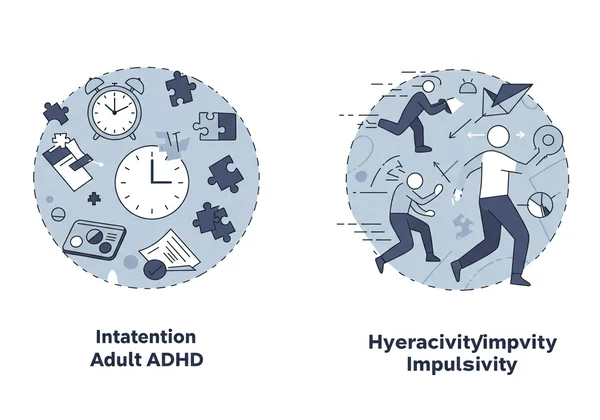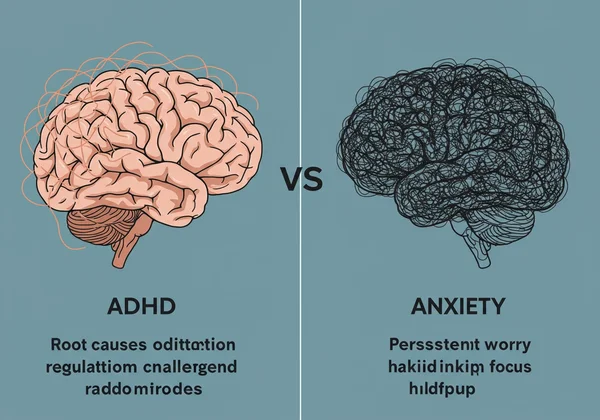Adult ADHD vs. Anxiety: Key Differences, Symptoms, and How the ASRS Test Can Help
Feeling overwhelmed, restless, or unable to focus? It's a common experience for many adults, but when these feelings persist, it's natural to wonder about the cause. Often, the conversation leads to two possibilities: Adult ADHD and anxiety. The symptoms can overlap so much that telling them apart feels like an impossible puzzle. Is your mind racing because of anxiety, or is it the hallmark of an ADHD brain? This guide is here to help you understand the key differences, explore why they often appear together, and provide clear steps you can take to find clarity. An online ASRS test can be one of those steps.
The journey to understanding yourself begins with knowledge. While this article offers insights, a structured self-assessment can provide a valuable starting point. Consider taking a confidential ASRS test to organize your thoughts and observations before speaking with a professional.

Untangling ADHD and Anxiety: Core Symptoms & ASRS Test Insights
To untangle the knot of symptoms, we first need to look at each condition individually. While they can share characteristics like restlessness and difficulty concentrating, their origins and core features are distinct. Understanding these foundations is the first step toward clarity.
Key Symptoms of Adult ADHD to Look For
Adult Attention-Deficit/Hyperactivity Disorder (ADHD) is a neurodevelopmental condition, meaning it originates in brain development and is typically present from childhood, even if it wasn't diagnosed then. It primarily affects the brain's executive functions—skills that help you manage time, organize tasks, and regulate emotions.
Understanding these symptoms is the first step in preparing for an adult ADHD test like the ASRS scale. Key symptoms often fall into two categories:
- Inattention: This isn't just about getting distracted by shiny objects. It’s a persistent difficulty with sustaining focus, especially on tasks that are tedious or uninteresting. This can look like:
- Making careless mistakes at work or in daily tasks.
- Struggling to follow conversations or instructions.
- Frequently misplacing items like keys, wallets, or phones.
- Chronic procrastination and trouble starting tasks.
- Hyperactivity/Impulsivity: The stereotypical image of a child bouncing off the walls often evolves in adults. It may manifest as an inner feeling of restlessness or an inability to relax. This can include:
- Constant fidgeting, tapping hands or feet.
- Feeling an intense, internal "buzz" or restlessness.
- Talking excessively and often interrupting others.
- Making impulsive decisions with finances, relationships, or career choices.
Understanding Generalized Anxiety Disorder (GAD) Symptoms
Anxiety, on the other hand, is primarily an emotional regulation disorder centered on excessive worry and fear. While everyone feels anxious sometimes, a disorder like GAD involves persistent, uncontrollable worry about various aspects of life, from health and finances to everyday responsibilities.
Common symptoms include:
- Psychological Symptoms:
- Constant, overwhelming worry that is difficult to control.
- Feeling on edge, tense, or keyed up.
- Difficulty concentrating because your mind is occupied by worry.
- Catastrophizing—imagining the worst-case scenario in any situation.
- Physical Symptoms:
-
Muscle tension and aches.
-
Fatigue and trouble sleeping (either falling asleep or staying asleep).
-
A racing heart, sweating, and trembling.
-
Stomach issues like nausea or irritable bowel syndrome (IBS).
-

ADHD or Anxiety? Key Differentiators for an Adult ADHD Test
Now that we've outlined the core symptoms, let's explore the crucial differences. The key to telling ADHD or anxiety apart often lies in the "why" behind the behavior, not just the "what."
Comparing the Root Causes: Where Impairment Begins
The fundamental difference is the origin of the distraction. For an adult with ADHD, difficulty focusing stems from a brain-based challenge with attention regulation. Their focus might drift because a new thought is more stimulating or because the current task is under-stimulating. The distraction is often random and not tied to a specific fear.
For someone with anxiety, the difficulty concentrating comes from a mind preoccupied with persistent worry. They can't focus on a report because they are consumed by thoughts like, "What if I get this wrong and get fired?" The distraction is fueled by fear and "what-if" scenarios.
Behavioral Manifestations and Thought Patterns
Consider procrastination. A person with ADHD might procrastinate because the task feels overwhelming, they don't know where to start, or their brain isn't producing enough dopamine to get motivated. The feeling is often one of paralysis or boredom.
In contrast, a person with anxiety might procrastinate out of perfectionism or fear of failure. They avoid the task because they are terrified of not doing it perfectly, and the thought of starting triggers their anxiety. The feeling is one of dread. These different cognitive patterns are a critical clue that an ADHD self-assessment like the ASRS test can help highlight.
Impact on Focus, Restlessness, and Relationships
Let's look at how overlapping symptoms manifest differently:
-
Focus: An ADHD brain struggles to direct its focus. An anxious brain's focus is hijacked by worry.
-
Restlessness: In ADHD, restlessness is often a physical need to move to burn off excess energy or to stimulate the brain. For anxiety, restlessness is a physical expression of internal tension and worry.
-
Social Challenges: Someone with ADHD might interrupt others impulsively or miss social cues due to inattention. Someone with social anxiety avoids social situations due to an intense fear of judgment.

When They Co-Occur: ADHD and Anxiety Comorbidity
To make matters even more complex, it's very common to have both ADHD and anxiety. This is known as ADHD comorbidity. Research suggests that about 50% of adults with ADHD also have an anxiety disorder.
Understanding the Link: Why They Often Appear Together
Living with undiagnosed or unmanaged ADHD can be inherently anxiety-provoking. When you constantly struggle with deadlines, forget important events, and face criticism for being "lazy" or "careless," it's natural to develop anxiety. The chronic stress of trying to navigate a world not built for your brain can directly lead to an anxiety disorder. This is why a thorough screening, such as a free adhd test for adults, is so important to differentiate the root cause. In this case, the anxiety is often a secondary condition resulting from the primary challenges of ADHD.
Navigating Dual Conditions and Symptom Overload
When both conditions are present, it can feel like a constant battle on two fronts. The impulsivity of ADHD might fuel anxious thoughts, while the worry from anxiety can make ADHD-related executive dysfunction even worse. It's a challenging cycle, but identifying that both may be at play is a crucial step toward finding the right kind of support and treatment that addresses each condition effectively.

Next Steps: Using an Online ADHD Screening to Talk to a Professional
Untangling these symptoms on your own is difficult. The most important step you can take is to speak with a healthcare professional, such as a doctor, psychiatrist, or therapist, who has experience with both adult ADHD and anxiety disorders.
Preparing for Your Consultation: What to Share
To make the most of your appointment, it helps to come prepared. Think about specific examples from your life. Don't just say, "I have trouble focusing." Instead, explain: "During team meetings, I find my mind wandering after five minutes, and I can't recall what was said." Note when these symptoms started. ADHD symptoms will have been present in some form since childhood, whereas anxiety may have developed later. An online ADHD screening like the ASRS test offers a structured way to gather your thoughts.
How Our Platform Supports Your ASRS Test Journey
Before your appointment, taking a preliminary screening like the ASRS ADHD test can provide a structured overview of your experiences. The Adult ADHD Self-Report Scale (ASRS) is a tool developed by the World Health Organization, also known as the ASRS scale. This ADHD ASRS test is designed to help identify symptoms consistent with adult ADHD.
On our platform, you can take the ASRS test for free and confidentially. The process is simple: you answer 18 questions about your experiences over the past six months. Afterward, you'll receive an AI-powered personalized report. This report from our ASRS test goes beyond a simple score, offering insights into your response patterns. It's not a diagnosis, but it is an excellent tool to help you articulate your concerns and provide a concrete starting point for a conversation with your doctor.

Untangling the Web: Finding Clarity and Support
Differentiating between ADHD and anxiety is a journey of self-discovery. Remember, the goal isn't to label yourself but to understand yourself better so you can get the right support. While their symptoms overlap, their roots are different—ADHD in attention regulation and anxiety in worry. They can also exist together, creating a complex picture.
Your path to clarity starts with observation and seeking professional guidance. By understanding these conditions and using a validated tool like the ASRS test for ADHD, you are taking a powerful step forward.
Ready to take that first step? Visit our website to start your screening and receive your AI-powered report from our ASRS test. It’s a confidential, insightful tool to support your journey.
Frequently Asked Questions About ADHD & the ASRS Test
What feels like ADHD but isn't?
Several conditions can mimic ADHD symptoms. Besides anxiety, these include depression (which can cause brain fog and low motivation), sleep deprivation, thyroid issues, and even vitamin deficiencies. This is why a comprehensive evaluation by a professional is essential to rule out other potential causes.
Is it worth getting an ADHD diagnosis?
For many, receiving an official diagnosis is life-changing. It provides validation, explains lifelong struggles, and opens the door to effective treatments, including therapy, coaching, and medication. An initial ASRS test online can be the first step on this validating journey. Understanding your brain's wiring empowers you to develop strategies that work with it, not against it.
How can I test myself for ADHD?
While you cannot diagnose yourself, you can start with a validated screening tool. The Adult ADHD Self-Report Scale (ASRS), often called the ASRS test, is a widely used and respected first step. You can try our free ASRS test tool today on our website to see how your symptoms align with the common indicators of adult ADHD, giving you a clear document to discuss with a healthcare professional.
What does the ASRS assess specifically?
The ASRS scale is designed to assess the frequency of symptoms related to both inattentive and hyperactive/impulsive types of ADHD in adults. The questions on this ASRS ADHD test are based on the diagnostic criteria found in the DSM-5 and focus on real-world situations, such as difficulties with task completion, organization, and impulse control. It’s a powerful ASRS test for initial self-reflection.